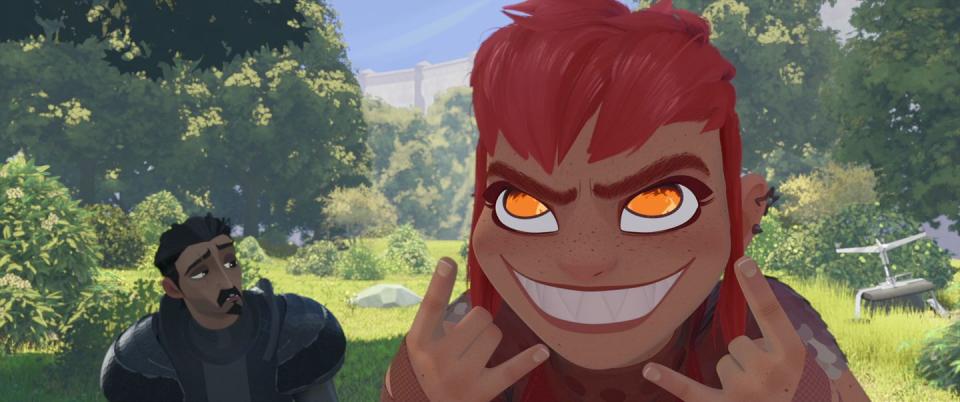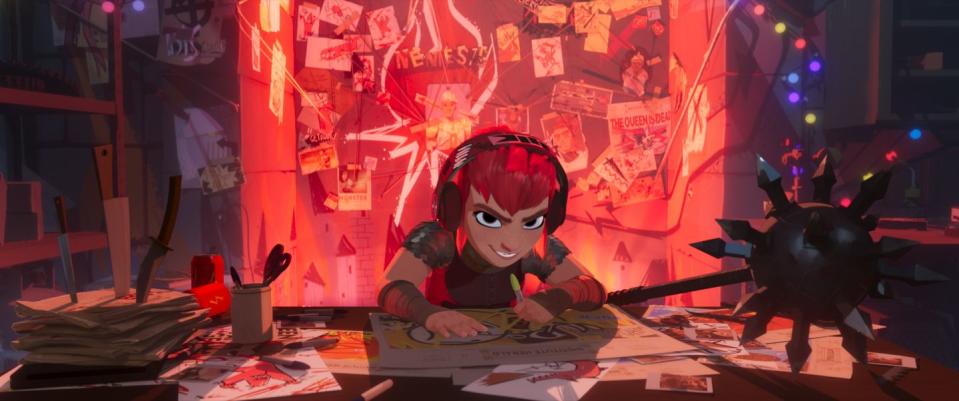How Netflix's Nimona defies conventions as an LGBTQ-diverse, groundbreaking movie

It’s been a bumpy road for Nimona, the latest Netflix release, but it’s all been worth it: the adaptation of ND Stevenson’s award-winning graphic novel is a beautiful, delightful and trailblazing animated movie, and the streamer’s best release of the year so far.
Beyond its striking animation and its hilarious sense of humour, one of the most impressive aspects of the movie is its rich and diverse representation of the LGBTQ+ community, both explicitly and allegorically.
Even in a medieval-science-fantasy world where sword-fighting collides with futuristic technology, the story is painfully relevant. Directors Nick Bruno and Troy Quane (Spies in Disguise) made sure to maintain the disruptiveness and rebellious spirit of the original material, while making a testament against intolerance and the fear of otherness.
Nimona follows the unexpected friendship between a one-armed knight Ballister (voiced by Riz Ahmed), who has been unfairly maligned as public enemy No1 in the realm, and an angry, punky shape-shifter called Nimona (voiced by Chloë Grace Moretz), who insists on being his sidekick as they question the foundations of the world they live in.

Nimona’s origins: from a beloved webcomic to movie studio troubles
The journey to Nimona started back in 2012, when a young ND Stevenson (who acts as co-producer for the movie) decided to self-publish the illustrated story online. In 2015, the work was published as a graphic novel at HarperCollins, eventually earning an Eisner Award and a National Book Award nomination.
Stevenson, who since then has come out as transmasculine and non-binary (in his own words: "My pronouns are he/him, but I am not (entirely) a boy"), created Nimona out of his own experiences at the time, even if he wasn’t totally aware of that yet. “She is a character with a lot of pain and anger at her heart, and that’s why she exists,” he said in an interview with The Hollywood Reporter. “When I made her, I was doing it for my own catharsis.”
While studying illustration in the Maryland Institute College of Art, the author was inspired by trailblazing animated shows like Adventure Time and Steven Universe, which were pushing the boundaries for LGBTQ+ characters on TV. Later on, Stevenson did the same as showrunner of the subversive reboot She-Ra and the Princesses of Power.

“Being out in the world as a young adult, I was very quickly questioning everything I have been taught my entire life. That’s a very disorienting thing to do, to try to figure out what you believe, just based on your perception of the world and what’s going on,” he explained.
“It’s about who we really are versus who we think we are, who we are trying to be, and who we say we are.”
The adaptation of Nimona to the big screen was soon on the table. The project was first picked up by Blue Sky Studios, but the Disney-Fox merger paused the production indefinitely, and ultimately shuttered the small animation studio completely. The movie didn't find support at Disney either, as the company might have pushed to censor a same-sex kiss in the movie (according to Insider).
Luckily, the creative team wanted this adaptation so badly they even launched their own studio, Shapeshifter Films, until Annapurna Pictures came on board. In April 2022 it was announced Netflix was going to distribute the film worldwide.

How Nimona explores the trans experience and brings forward LGTBQ+ narrative
*Nimona spoilers follow*
In one scene of Netflix’s Nimona, Ballister asks Nimona how it feels to shape-shift. "Does it hurt?" he says.
"Honestly, I feel worse when I don't do it," she explains. "Like my insides are itchy. Then I shape-shift, and I'm free."
"What if you held it in?" he asks back.
"I'd die," she replies, joking, before adding: "I wouldn't die die, I just sure wouldn't be living."

Informed by ND Stevenson's own feelings and experiences, Nimona has an inherent transness and gender-fluid nature. It's not only about her ability to shape-shift (she can literally turn into any kind of animal or person, even a dancing shark), but also about the constant rejection amongst her people, the rage created through years of isolation, and the longing for family and acceptance.
There are also darker elements of her story that are reminiscent of feelings of self-harm and depression, conveyed through some heartbreaking scenes.
Thankfully, Nimona hasn't lost her innocence, her sense of humour and her will to make a change in the world. She refuses to be categorised, so we are never told what type of mythical creature she is. It doesn't matter: as the character reminds us numerous times, she's just Nimona. She's just herself.

Perhaps when the movie is clearest about this allegory is when it shows the persecution Nimona suffers by so-called heroes, who keep telling her to go back to the shadows.
This fictional society is founded on the story of Gloreth, a great warrior who defeated a great evil a thousand years back, creating a long-standing league of knights to defend the kingdom. As we find out later in the movie, that great evil was in fact Nimona, who was friends with Gloreth until other people's fears turned their friendship into hate.
In the present day, it's the director of the Institute of Knights who carries on with Gloreth's task of spreading fear against the unknown. When she says monsters "threaten our way of life", it's difficult not to hear the echo of transphobic movements trying to uphold a traditional social order in spite of real people's experiences and identities.

Nimona's disruptiveness is not an exception in the story. While monsters are hunted down without asking questions, at least this realm is gay-friendly. Ballister and popular knight Ambrosius Goldenloin show their love openly without fear of persecution, neither is their strength as warriors questioned because of their sexual orientation.
It's so refreshing to see a gay romance at the centre of a story, especially when the challenges they have to face are not homophobia-related. Ballister and Ambosius are layered, complex characters sharing a beautiful romance in plain sight. How ridiculous it is to find this shocking in 2023!
Alas, this kind of representation is not seen often in animated family-friendly movies, besides recent exceptions such as Disney's Strange World.

Beyond all these groundbreaking characters and stories, Nimona is also a universal tale.
"I think that she is something that we all have inside of us that we don't get to express very often," said Stevenson in an interview with ScreenRant.
"She expresses things. She's very true to her inner emotions, and she has this way of manifesting them physically. I thought she was a really personal character, and she is, but so many people relate to her. All kinds of people. I think we all have a little Nimona in us," he added.
Let's hope Nimona finds success as it joins the Netflix catalogue, opening new doors for many more smart, funny and heartwarming LGBTQ+ stories to come.
Nimona is available to watch on Netflix.
You Might Also Like

 Yahoo Movies
Yahoo Movies 
